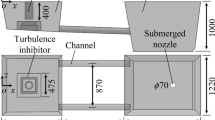Abstract
The purpose of this paper is to investigate the feasibility of high-frequency induction heat for the line heating process through a series of experimental studies and numerical calculations. The results show that the heating temperature of induction heating meets the demands of steel plate bending, and the deformation of a steel plate heated by induction heating can achieve the same effect as flame heating. Meanwhile, the finite element model of moving induction heating of the plate is developed, and the comparison of the residual strain fields and transverse shrinkage between these two kinds of heating shows that great similarity has been achieved.
Similar content being viewed by others
References
Bae KangYul, Yang YoungSoo, Hyun ChungMin, Cho SiHun (2008). Derivation of simplified formulas to predict deformations of plate in steel forming process with induction heating. International Journal of Machine Tools and Manufacture, 48(15), 1646–1652.
Hao Hai, Jin Junze, Zhang Xingguo (1999). Study on induction heat in electromagnetic casting. Foundry, 8, 5–9.
Kihara H (1973a). Effect of fabricating method at assembly stage on notch toughness of steel plates: Thermoplastic deformation and local brittleness due to line heating. Journal of Zosen Kyokai, 133, 319–329. (in Japanese)
Kihara H (1973b). Effect of fabricating method at assembly stage on notch toughness of steel plates: Effect of line heating condition on notch toughness of steel plates. Journal of Zosen Kyokai, 133, 319–329. (in Japanese)
Lee KS, Kim SW, Eom DH (2011). Temperature distribution and bending behavior of thick metal plate by high frequency induction heating. Materials Research and Innovations, 15(1), 283–287.
Liu F, Shi Y, Lei X (2009). Numerical investigation of the temperature field of a metal plate during high-frequency induction heat forming. Proceedings of the Institution of Mechanical Engineers, Part C. Journal of Mechanical Engineering Science, 223(4), 979–986.
Shuai Kegang, Luo Yu, Sha Wanhua, Xie Lei (2004). FEM analysis of the temperature field of high frequency induction heating in plate bend molding. Boiler Technology, 35(3), 52–54.
Ueda Y, Murakawa H, Mohamed A, Okumoto Y (1994a). Development of computer-aided process planning system for plate bending by line heating (report 1): Relation between final form of plate and inherent strain. Journal of Ship Production, 10(1), 59–67.
Ueda Y, Murakawa H, Mohamed A, Okumoto Y (1994b). Development of computer-aided process planning system for plate bending by line heating (report 2): Practice for plate bending in shipyard viewed from aspect of inherent strain. Journal of Ship Production, 10(4), 239–247.
Ueda Y, Murakawa H, Mohamed A, Okumoto Y (1994c). Development of computer-aided process planning system for plate bending by line heating (report 3). Relation between heating condition and deformation. Journal of Ship Production, 10(4), 248–257.
Yang Shiming (2003). Fundamentals of heat transfer. Advanced Education Press, Beijing, China, 10–50.
Yoshihiko T (2003). Automated line heating for plate forming by HIH-ALPHA system and its application to construction of actual vessels. Journal of the Society of Naval Architects of Japan, 193, 85–95.
Zhang Xuebiao, Liu Yujun, Hu Xuefeng, Ji Zhuoshang (2009). Experimental analysis and numerical simulation of induction heat forming of steel plate. Journal of Harbin Engineering University, 30(3), 238–243. (in Chinese).
Author information
Authors and Affiliations
Corresponding author
Additional information
Foundation item: Supported by the National Natural Science Foundation of China (50805016).
XueBiao Zhang was born in 1974 and is an associate professor. He received the PhD degree from Dalian University of Technology in 2006. His current research interest is hull plate forming by a high frequency induction source.
Yulong Yang was born in 1988. He is presently a postgraduate student at Dalian University of Technology. His current research interest is hull plate forming by high frequency induction heating.
YuJun Liu is a Professor. He received a PhD degree from Dalian University of Technology in 1997. He is the Director of the China Society of Naval Architects & Marine Engineers. He has published over 30 papers in domestic journals. He has obtained the Second Class Honor of National Scientific Advancement in 2000, and the First Class Honor of Scientific Result Application of the Dalian city government in 2001. His current interests are line heating forming of a ship hull and ship production accuracy control technology.
Rights and permissions
About this article
Cite this article
Zhang, X., Yang, Y. & Liu, Y. Feasibility research on application of a high frequency induction heat to line heating technology. J. Marine. Sci. Appl. 10, 456–464 (2011). https://doi.org/10.1007/s11804-011-1091-0
Received:
Published:
Issue Date:
DOI: https://doi.org/10.1007/s11804-011-1091-0




